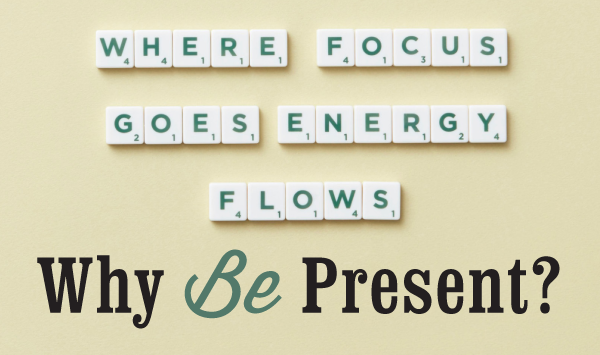
For the past decade or so there has been an increase in curiosity on the topic of “being present” and the light it has shed on having a better quality of life. It has provoked many questions as to the important role it can play in having a better relationships with oneself or others, the ability to feel more connected to your life and purpose as a whole.
For many, this has been a lifestyle for decades. For most, it has gained more prominence as the stresses of life get to be overwhelming and people are urged to find a way to manage stress or pressure.
“When we show up to the present moment with all of our senses, we invite the world to fill us with joy. The pains of the past are behind us. The future has yet to unfold. But the now is full of beauty simply waiting for our attention.” —Moya Watson
Being fully present means engaging your senses. When you tune in to what is happening in the moment, you open your eyes and can see more clearly. When you truly listen, you can hear the heart of another. When you take the time to pause all distractions you can hear your own heart, too. You can feel the energy, or lack of energy, when you touch with full participation, in the moment. When you breathe in and engage your sense of smell you can identify the aromas that tell a story about what is happening in that moment. When you taste the moment you are in, you can savor the flavor.
I intentionally use the term “in the moment” with the above phrases, as that is the key to the art of being present. Yes, it is an art form.
“Art: A skill that is attained by study, practice and observation” —Farlex Dictionary.
Notice what is, not what was or what might be. Being present is another way of putting worry “on the shelf.” If you’re too busy thinking about what could happen, chances are you are missing the joy or fullness of what is actually happening. If you aren’t paying attention, the moment passes and you only got to “taste” or savor a crumb instead of the whole bite!
When you give someone your undivided attention, you offer the ability for more authenticity and openness. There is an alertness or attentiveness that says “I am listening; I hear you.” When you look someone in the eye, it connects you both on a deeper level. It may only be for an instant, but it says “I see you. I am witnessing you right now.” It creates a sense of appreciation that they matter, and that you matter.
“Listening is about being present, not just about being quiet.” —Krista Tippett
Lose the distractions. Anything that takes your attention away from what is currently happening is a distraction. The literal breakdown of that word is: dis—apart from, traction—the act of drawing or pulling toward.
You disengage with the person you are talking to or you miss the part in the movie or recital when you pick up your phone, look around or otherwise interrupt the moment. It is a discipline, now more than ever, to stop engaging in the distractions and connect with the conversation, activity or event that is taking place.
“Absence sharpens love, presence strengthens it. We convince by our presence.” —Thomas Fuller
Have you ever been talking with someone and they take their eyes off you for a second because they got distracted by someone else walking in, or the phone in their hand rang or dinged? Can you feel their interest in you shift? All of a sudden something or someone else became more important than you. Have you done that to someone else? I think it’s happened to everyone, multiple times. This is a perfect opportunity to practice staying present. Even if you’re bored, give your full attention to that moment. The moment will pass, and you’ll be able to move on to the next person, place or thing, but the opportunity to make another feel like they matter will last. It will become your reflection as well. What you project is what you reflect. That quality will attract or distract others from participating in what matters to you.
Being present allows you to focus all of your energy on the task at hand, because, as Tony says, “Where focus goes, energy flows.” —Tony Robbins
Wherever you are, when you are finished reading this I encourage you to STOP. BREATHE IN. EXHALE. Notice the smells where you are. What sounds can you identify? What thoughts come up for you after reading this? Can you “taste” an experience of something you were reminded of in this article? Hold it for a moment. That is being present. Congratulations. You are on your way to developing the art of Being Present.













